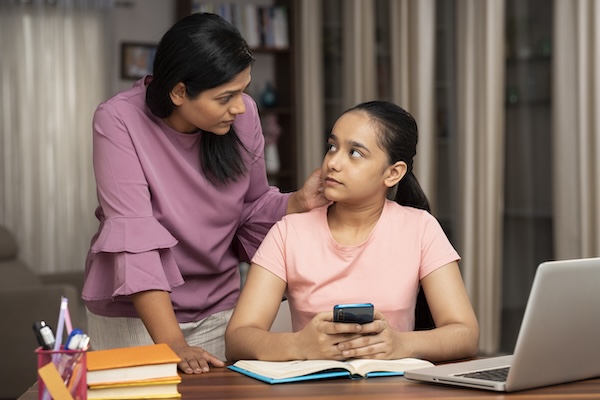.png)
Akshay Kumar, Parenting, and the Lie We Tell Ourselves
We tell ourselves control is safety. It isn’t. True protection begins with trust, not surveillance—connection, not control.


Kirti Tarang Pande is a psychologist, researcher, and brand strategist specialising in the intersection of mental health, societal resilience, and organisational behaviour.
October 7, 2025 at 7:05 AM IST
It’s shocking how certain things don’t shock us anymore. When Akshay Kumar spoke about his 13-year-old daughter being asked to share her nude picture during an online game, it sparked an empathetic reaction amidst parents—a grim, knowing nod. Yeah, it happens. It’s happened to mine. Pedophiles preying on minors is not a “What?!” moment anymore. It’s a quiet, chilling, “Yes, and that’s why I…” We’ve built an entire lexicon of resignation disguised as vigilance:
We supervise screen time
We pre-check games
We ban chat rooms
We repeat the mantra: don’t talk to strangers.
We tell our children to put down the device and go outside.
I am sorry to burst your bubble that these strategies don’t work. And here’s why:
Because many parents have converted anxiety into rituals of control that look busy but largely miss the psychological point. Supervision, profile‑checking, banning chats, and the rote admonition “don’t talk to strangers” are expressions of vigilance, but they are not the same thing as equipping a child with the psychological tools to recognise, resist, and report abuse. And the notion that boys are somehow exempt is a myth; risk and vulnerability do not reliably map onto gender.
The central error in these common practices is conflating external control with internal competence. Surveillance treats the child as the object of protection rather than the subject of preparation; psychology shows that monitoring without open, trusting communication fosters secrecy and shame, which are precisely the states predators rely on to conceal grooming.
When children learn to hide because they fear punishment or judgement, their capacity to disclose is crippled and predators gain cover. Pre‑checking a game or setting up profiles addresses visible hazards but ignores the adaptive, covert strategies predators use—private messages, innocuous toyed conversations, flattery and emotional coaching—so these checks are like scanning the well‑worn paths while predators slip through the undergrowth.
Simple prohibitions such as “don’t talk to strangers” rest on an undeveloped model of how grooming works. Grooming is rarely initiated by an obvious stranger in monster guise; it is a slow, relational process that recruits trust, shared secrets, and perceived intimacy.
Developmentally, children—particularly younger ones—are wired to seek approval and connection and are still learning social cues, making them susceptible to approaches framed as friendship or mentorship. Telling a child to refuse a stranger assumes a child can always identify the stranger, which is often false; psychopathology-based manipulation exploits children’s burgeoning social needs and limited experience.
Encouraging outdoor play or replacing screen time with analogue activities can reduce exposure, but it is not a preventative panacea. Digital spaces are woven into children’s social worlds; isolation from them can create gaps in social belonging or prompt covert re‑engagement in unsupervised contexts. Moreover, framing outdoor activity as a moral substitute for online life can inadvertently stigmatise a child’s legitimate friendships formed online, pushing those relationships into secrecy where risk grows.
Parental control apps and intrusive monitoring produce their own psychological harms: they can erode trust, undermine autonomy, and provoke oppositional behaviour that leads children to develop circumvention skills. From the perspective of self‑determination theory, children need autonomy, competence, and relatedness to flourish; heavy surveillance thwarts autonomy and relatedness and therefore weakens the child’s internal resources for safe decision‑making. In short, technological control without relational scaffolding is a placebo that soothes parental fear while leaving the child less prepared to resist manipulation.
We have been sold a lie—that control is synonymous with safety. Supervision, we are told, is protection. Yet any psychologist worth their salt will tell you that surveillance without understanding breeds secrecy, not security. When a child feels watched but not heard, they don’t stop taking risks—they just get better at hiding them. These solutions, however well-intentioned, are psychological placebos. They soothe the parent but do little to arm the child.
As my husband, an army man, with specialisation in cyber security puts it bluntly: no fortress is impregnable. The creeps will always find a way to creep in.
Then what should we do!
A more psychologically sound response reframes the aim from absolute prevention through restriction to durable protection through empowerment. For the youngest children, protection means teaching body autonomy in plain, repeated language: their body belongs to them, they can say “no,” and they must tell a trusted adult if something feels wrong, with practice through play and stories so the message becomes accessible, not terrifying.
In primary school, it means translating abstract rules into concrete skills—how grooming starts, how adults can deceive, how to refuse and to tell—practiced in role‑plays and supported by adults who respond calmly and credibly when disclosures occur. For adolescents, the work is psychological literacy: conversations about consent, emotional coercion, boundary negotiation, and online signalling that normalise help‑seeking and demystify shame. For young adults, the emphasis shifts toward peer accountability, bystander intervention, and critical digital literacy so they can recognise exploitative patterns and support others.
This approach requires three relational pivots. First, build trust before crises occur so children expect empathy and not punishment when they disclose, because disclosure is the defensive mechanism that stops abuse. Second, teach skills rather than issuing prohibitions—practical refusal language, how to screenshot and preserve evidence, how to block and report safely, and whom to contact immediately. Third, hold space for children’s social lives, including their online friendships, so those lives are visible and discussable rather than hidden and shameful.
At a societal level, the psychological stakes are high. India’s rapid digital expansion exposes millions of children to new vectors of harm, but the fundamental fragility is not the network; it is unprepared minds and unsupported relationships. When children are psychologically weapon‑ready—equipped with autonomy, emotional vocabulary, and trusted adults—they form the most resilient firewall against predators. When society substitutes walls for teaching, it builds fearful inhabitants rather than capable citizens.
So let indignation be the catalyst for change, not an end in itself. Question why well‑meaning solutions have failed, and replace control rituals with developmental, evidence‑based practices that cultivate resilience and disclosure. The goal is not to cage children but to arm them with the knowledge, language, and relational security to navigate risk; the real firewall is not code but compassion, competence, and connection.



